PREDICTING RECOVERY IN ACIDIFIED FRESHWATERS BY THE YEAR 2010, AND BEYONDContract EVK1-1999-00087 - RECOVER:2010 Part of the 'Sustainable Management and Quality of Water' Ecosystem Functioning Directorate General Research |
|||||||||
|
Slovakia
Tatra Mountain Lakes
Site characteristics:
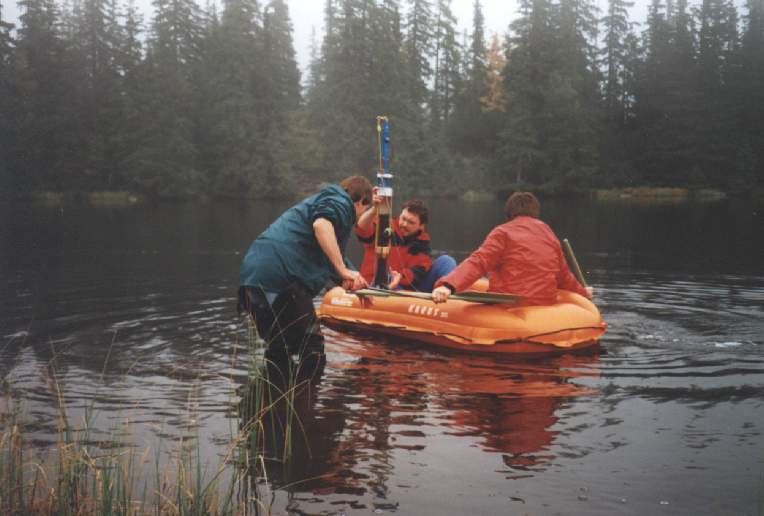 The Tatra Mountains belong to the Carpathian chain and are situated along the Slovak-Polish border (20o 10' E, 49o10' N; maximum altitude of 2654 m a.s.l.). The Tatra Mts. consists of three mountain ranges. (1) The West Tatra Mts. (~400 km2) are formed of granite, gneiss, mica schist, and limestone. Soils are undeveloped or acid podzols. There are 22 major lakes (perennial and > 0.01 ha) and 18
small lakes (seasonal or < 0.01 ha) in this range. (2) Central part called the High Tatra Mts. (260 km2including the Polish Tatra Mts.) has predominantly granitic bedrock; soils are undeveloped or acid podzols. There are 116 major lakes (perennial and > 0.01 ha) and 105 small lakes (seasonal or < 0.01 ha) in this area. (3) Eastern part is called the Belanské Tatry Mts. (64 km2). This area is formed of limestone and dolomite and is lakeless.
The Tatra Mountains belong to the Carpathian chain and are situated along the Slovak-Polish border (20o 10' E, 49o10' N; maximum altitude of 2654 m a.s.l.). The Tatra Mts. consists of three mountain ranges. (1) The West Tatra Mts. (~400 km2) are formed of granite, gneiss, mica schist, and limestone. Soils are undeveloped or acid podzols. There are 22 major lakes (perennial and > 0.01 ha) and 18
small lakes (seasonal or < 0.01 ha) in this range. (2) Central part called the High Tatra Mts. (260 km2including the Polish Tatra Mts.) has predominantly granitic bedrock; soils are undeveloped or acid podzols. There are 116 major lakes (perennial and > 0.01 ha) and 105 small lakes (seasonal or < 0.01 ha) in this area. (3) Eastern part is called the Belanské Tatry Mts. (64 km2). This area is formed of limestone and dolomite and is lakeless.
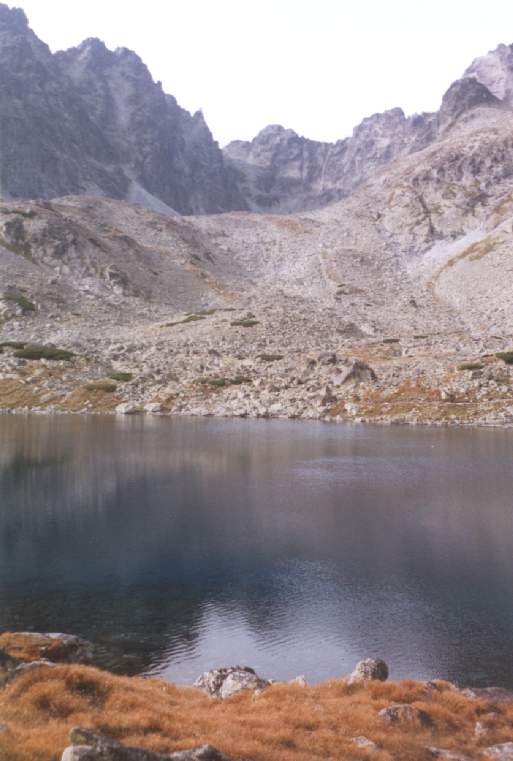 The Tatra lakes are of glacial origin and are situated at altitudes between 1089 and 2157 m. Most of the lakes (~70%) are in the alpine zone above 1800 m. Surface areas of lakes range from <0.01 to 34.5 ha and maximum depths from <0.5 to 79.3 m.. Larger lakes are mostly drainage lakes and the small ones are frequently seepage lakes. Lakes are mostly fishless, except for a few lakes in the West Tatra Mts. populated
with bullhead, and in the High Tatra Mts. populated (mostly artificially) with brook and brown trout. Records on zooplankton exist from > 70% of the major Tatra lakes; 102 lakes are (and/or were in the past) populated by planktonic crustacea. Compared to the pre-acidification records, present species composition of planktonic crustacea is unchanged in non-acid lakes (pH > 6), extinct in acid (5 < pH < 6) lakes, and modified in strongly acid (pH < 5) lakes (Stuchlík et al., 1985; Fott et al., 1994).
The Tatra lakes are of glacial origin and are situated at altitudes between 1089 and 2157 m. Most of the lakes (~70%) are in the alpine zone above 1800 m. Surface areas of lakes range from <0.01 to 34.5 ha and maximum depths from <0.5 to 79.3 m.. Larger lakes are mostly drainage lakes and the small ones are frequently seepage lakes. Lakes are mostly fishless, except for a few lakes in the West Tatra Mts. populated
with bullhead, and in the High Tatra Mts. populated (mostly artificially) with brook and brown trout. Records on zooplankton exist from > 70% of the major Tatra lakes; 102 lakes are (and/or were in the past) populated by planktonic crustacea. Compared to the pre-acidification records, present species composition of planktonic crustacea is unchanged in non-acid lakes (pH > 6), extinct in acid (5 < pH < 6) lakes, and modified in strongly acid (pH < 5) lakes (Stuchlík et al., 1985; Fott et al., 1994).
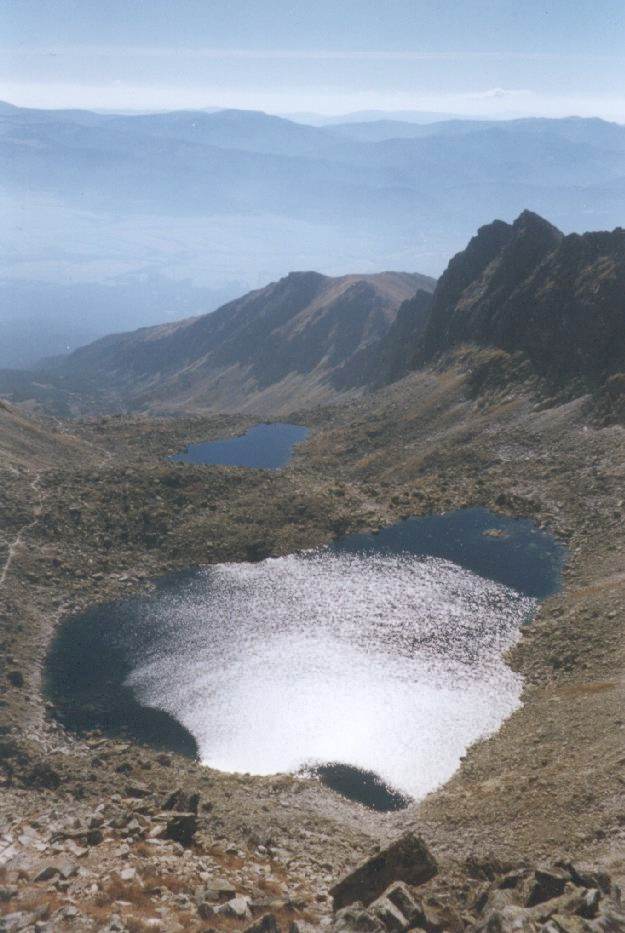 Grazing, logging, or any other kind of land uses have been prohibited in the Tatra Mts. since 1949 and 1955, when the area became a national park in Slovakia and Poland, respectively. Tourism does not significantly influence lakes because swimming and fishing are prohibited, and tourist paths are not usually situated in a close vicinity of the lakes.
Grazing, logging, or any other kind of land uses have been prohibited in the Tatra Mts. since 1949 and 1955, when the area became a national park in Slovakia and Poland, respectively. Tourism does not significantly influence lakes because swimming and fishing are prohibited, and tourist paths are not usually situated in a close vicinity of the lakes.
The dominant vegetation of lake catchment areas is dependent on altitude: (1) coniferous forests below 1550-1650 m a.s.l. (mostly Picea abies, partly Larix decidua and Pinus cembra) with relatively sparse deciduous trees (Salix silesiaca, Betula pubescens and Sorbus aucuparia), (2) dwarf pine (Pinus mugo) between 1550 and ~1800 m a.s.l., and (3) alpine meadows (dry tundra dominated by Calamagrostis villosa, Festuca picta, and Luzula luzuloides) and rocks (bare rocks and/or rocks covered with lichens: commonly Rhizocarpon, Acarospora oxytona, and Dermatocarpon luridum) in the alpine zone above the upper tree line of 1800-1850 m a.s.l.
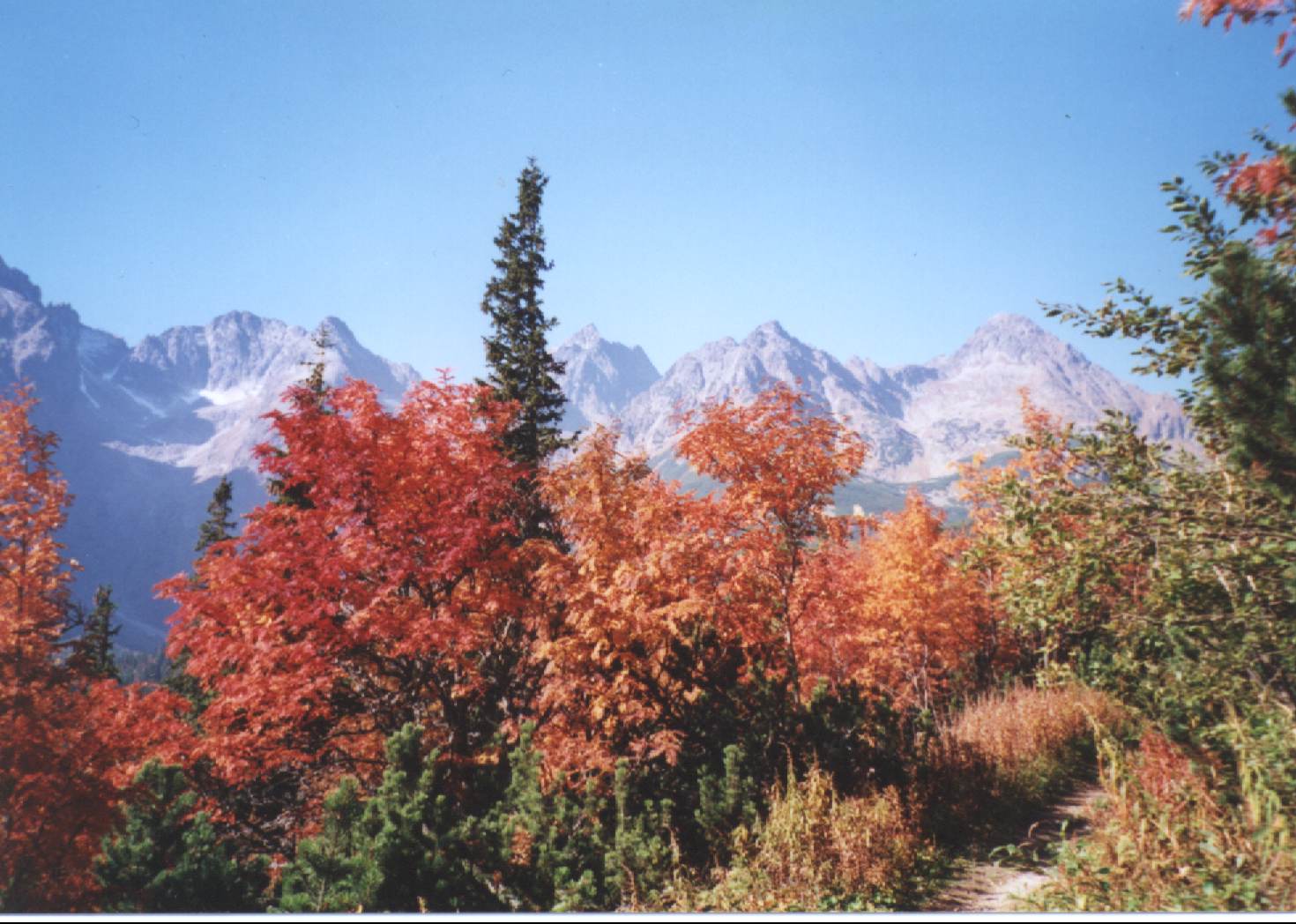 The Tatra Mts. lakes may be divided into 5 main groups according to the dominant catchment vegetation; lakes situated in: 1) forest, 2) dwarf pine bushes and meadows, 3) meadows, 4) meadows and rocks, and 5) rocks. Concentrations of total phosphorus, organic carbon, organic nitrogen, and chlorophyll-a, and bacterial numbers are highest in forest lakes, then they decrease in alpine lakes with decreasing amount of catchment vegetation and soil cover, and are the lowest in lakes
situated in bare rocks. Nitrate concentrations follow an inverse trend being lowest in forest lakes and then increasing with decreasing amount of catchment soils and vegetation (Kopácek et al. 2000).
The Tatra Mts. lakes may be divided into 5 main groups according to the dominant catchment vegetation; lakes situated in: 1) forest, 2) dwarf pine bushes and meadows, 3) meadows, 4) meadows and rocks, and 5) rocks. Concentrations of total phosphorus, organic carbon, organic nitrogen, and chlorophyll-a, and bacterial numbers are highest in forest lakes, then they decrease in alpine lakes with decreasing amount of catchment vegetation and soil cover, and are the lowest in lakes
situated in bare rocks. Nitrate concentrations follow an inverse trend being lowest in forest lakes and then increasing with decreasing amount of catchment soils and vegetation (Kopácek et al. 2000).
Atmospheric deposition of S and N compounds in Central Europe originates predominantly (65% to 85%) from emissions in the region (Berge, 1997). Consequently, any changes in Central European emission rates of S and N have correspond closely to parallel changes in deposition and chemistry of the Tatra Mountains lakes (Kopácek et al., 1998).
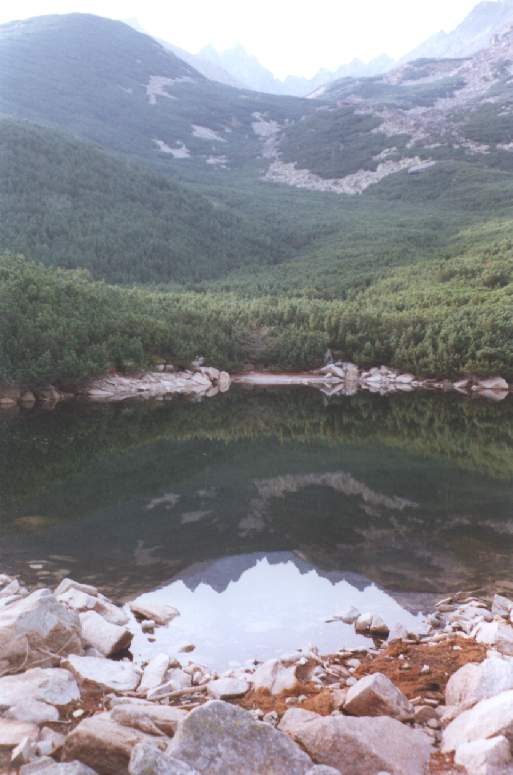 There are no direct records of the beginning of acidification-derived chemical changes of lake water composition in the High Tatra Mts. Nevertheless, a threshold of major changes in zooplankton communities was reached there between 1975 and 1978 (Fott et al. 1994). In the 1980s and early 1990s, however, all lakes in the High Tatra Mts. were already seriously affected by acidification: concentrations of
SO42- and NO3- were on average 33 µmol l-1 and 30 µmol l-1 higher, respectively, compared to their average background levels in 1938 (SO42- ~7.5 µmol l-1, NO3- ~1.5 µmol l-1; Stangenberg, 1938). The increase in SO42- and NO3- concentrations was related to the estimated average loss of HCO3- concentration ~100 µmol m-3 (Kopácek and Stuchlík, 1994). While
SO42- concentrations increased in all lakes regardless of the type of watershed, the NO3- levels were the highest (up to 52 µmol m-3) in lakes situated in alpine watersheds with sparse soils and vegetation, that is, at sites with the lowest nitrogen-retention capacities. Concentrations of SO42- and NO3- in the High Tatra lakes reached their maxima in the middle and late 1980s, respectively. Compared to the late 1980s, the acidification trend of the lakes has been clearly reversed in the
1990s. The decline in the lake water concentration of strong acid anions was compensated for (1) partly by a decline in base cations and (2) by an increase in alkalinity and pH (Kopácek et al., 1998). Examples of trends in the water chemistry of lakes situated in different types of watershed vegetation are given in Fig 1-5.
There are no direct records of the beginning of acidification-derived chemical changes of lake water composition in the High Tatra Mts. Nevertheless, a threshold of major changes in zooplankton communities was reached there between 1975 and 1978 (Fott et al. 1994). In the 1980s and early 1990s, however, all lakes in the High Tatra Mts. were already seriously affected by acidification: concentrations of
SO42- and NO3- were on average 33 µmol l-1 and 30 µmol l-1 higher, respectively, compared to their average background levels in 1938 (SO42- ~7.5 µmol l-1, NO3- ~1.5 µmol l-1; Stangenberg, 1938). The increase in SO42- and NO3- concentrations was related to the estimated average loss of HCO3- concentration ~100 µmol m-3 (Kopácek and Stuchlík, 1994). While
SO42- concentrations increased in all lakes regardless of the type of watershed, the NO3- levels were the highest (up to 52 µmol m-3) in lakes situated in alpine watersheds with sparse soils and vegetation, that is, at sites with the lowest nitrogen-retention capacities. Concentrations of SO42- and NO3- in the High Tatra lakes reached their maxima in the middle and late 1980s, respectively. Compared to the late 1980s, the acidification trend of the lakes has been clearly reversed in the
1990s. The decline in the lake water concentration of strong acid anions was compensated for (1) partly by a decline in base cations and (2) by an increase in alkalinity and pH (Kopácek et al., 1998). Examples of trends in the water chemistry of lakes situated in different types of watershed vegetation are given in Fig 1-5.
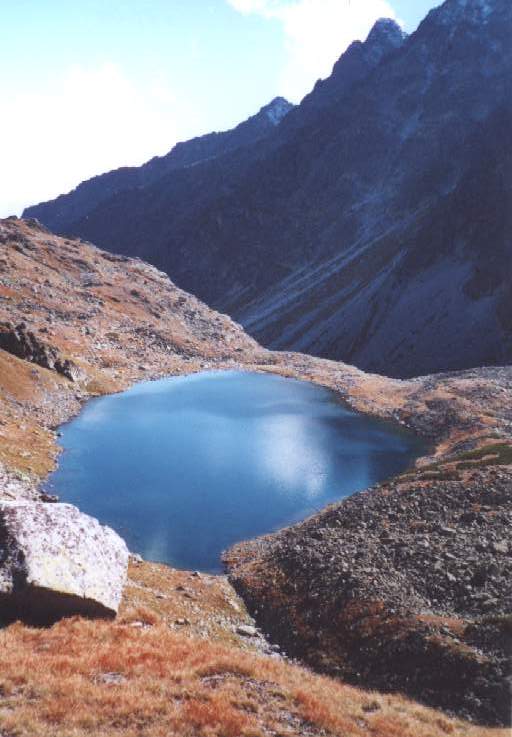 Present ionic content of the Tatra Mts. lakes is low (Table 1). Conductivity ranges from 11 to 47 µS cm-1 (at 20 oC). ANC and pH of the lakes varies from 0 to 338 µeq l-1 and from 4.25 to 7.31, respectively. Concentrations of major ions ranges between 10 and 380 µeq l-1 for Ca2+, between 3 and 153 µeq l-1 for Mg2+, between 0
and 340 µeq l-1 for HCO3-, between 33 and 154 µeq l-1 for SO42-, and between 0 and 56 µeq l-1 for NO3-. On average, Ca2+ is the dominant cation (70%) while HCO3- (45%) and SO42- (36%) dominate the sum of anions. The lake water ANC is primarily (P<0.001) determined by the content of Ca2+ and Mg2+ (Stuchlík, unpublished data).
Present ionic content of the Tatra Mts. lakes is low (Table 1). Conductivity ranges from 11 to 47 µS cm-1 (at 20 oC). ANC and pH of the lakes varies from 0 to 338 µeq l-1 and from 4.25 to 7.31, respectively. Concentrations of major ions ranges between 10 and 380 µeq l-1 for Ca2+, between 3 and 153 µeq l-1 for Mg2+, between 0
and 340 µeq l-1 for HCO3-, between 33 and 154 µeq l-1 for SO42-, and between 0 and 56 µeq l-1 for NO3-. On average, Ca2+ is the dominant cation (70%) while HCO3- (45%) and SO42- (36%) dominate the sum of anions. The lake water ANC is primarily (P<0.001) determined by the content of Ca2+ and Mg2+ (Stuchlík, unpublished data).
Table 1 Concentration ranges of major ions, nutrients and chlorophyll-a, in the Tatra lakes (including both forest and alpine lakes) in 1993-1994. (ANC - Gran titration; TON - total organic N, TN - total N, SRP - soluble reactive P, TP - total P, COD - chemical oxygen demand, TOC - total organic C, n - number of lakes analyzed for the particular parameter). Derived from (Kopácek et al. 2000).
| Minimum | 25% | Median | 75% | Maximum | n | ||
|---|---|---|---|---|---|---|---|
| pH | 4.25 | 5.44 | 6.14 | 6.54 | 7.31 | 84 | |
| ANC | µeq l-1 | 0 | 2.3 | 40.1 | 110 | 338 | 84 |
| SO42- | mg l-1 | 1.61 | 2.73 | 3.35 | 3.77 | 7.40 | 80 |
| Cl- | mg l-1 | 0.10 | 0.18 | 0.25 | 0.34 | 1.07 | 80 |
| Ca2+ | mg l-1 | 0.20 | 1.56 | 2.68 | 3.60 | 7.47 | 79 |
| Mg2+ | mg l-1 | 0.04 | 0.09 | 0.14 | 0.18 | 1.86 | 79 |
| Na+ | mg l-1 | 0.05 | 0.29 | 0.40 | 0.57 | 2.50 | 77 |
| K+ | mg l-1 | 0.03 | 0.13 | 0.17 | 0.25 | 0.71 | 77 |
| (NO3+NO2)-N | µg l-1 | <5 | 227 | 449 | 580 | 781 | 84 |
| NH4-N | µg l-1 | <5 | 5 | 10 | 18 | 164 | 84 |
| TON | µg l-1 | 5 | 50 | 76 | 150 | 825 | 84 |
| TN | µg l-1 | 212 | 423 | 562 | 679 | 897 | 84 |
| SRP | µg l-1 | <0.5 | <0.5 | 0.5 | 0.9 | 10.4 | 75 |
| TP | µg l-1 | 0.7 | 1.9 | 2.9 | 6 | 51.6 | 84 |
| COD | mg l-1 | <0.5 | 1.6 | 0.7 | 2.9 | 32.7 | 84 |
| TOC | mg l-1 | <0.05 | 0.17 | 0.4 | 1.11 | 14.3 | 43 |
| Clorophyll-a | µg l-1 | <0.05 | 0.12 | 0.56 | 1.18 | 34.2 | 83 |
References:
Berge E. (1997) Transboundary air pollution in Europe, Part 1, EMEP MSC-W Report 1/97, Norwegian Meteorological Institute, Oslo, 108 pp.
Fott J., Prazáková M., Stuchlík E. & Stuchlíková Z. (1994) Acidification of lakes in Šumava (Bohemia) and in the High Tatra Mountains (Slovakia). Hydrobiologia, 274, 37-47.
Kopácek J. & Stuchlík E. (1994) Chemical characteristics of lakes in the High Tatra Mountains, Czechoslovakia. Hydrobiologia, 274, 49-56.
Kopácek J., Stuchlík E., Fott J., Veselý J. & Hejzlar J. (1998) Reversibility of acidification of mountain lakes after reduction in nitrogen and sulphur emissions in Central Europe. Limnology and Oceanography, 43, 357-361.
Kopácek J., Stuchlík E., Straškrabová V. & Pšenáková P. (2000) Factors governing nutrient status of mountain lakes in the Tatra Mountains. Freshwater Biology 43, 369-383.
Stangenberg M. (1938) Zur Hydrochemie der Tatraseen. Verhandlungen der internationalen Vereinigung für theoretische und angewandte Limnologie, 8, 211-220.
Stuchlík E., Stuchlíková Z., Fott J., Ruzicka L. & Vrba J. (1985). Effect of acid precipitation on waters of the TANAP territory. Treatises concerning the Tatra National Park, 26, 173-211. (In Czech, with English summary).





